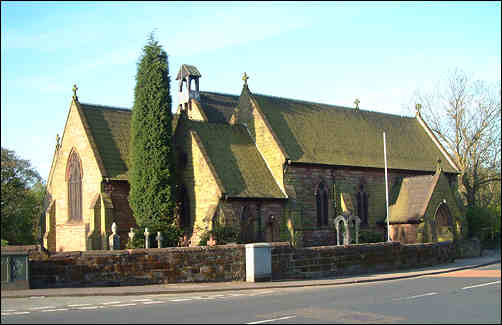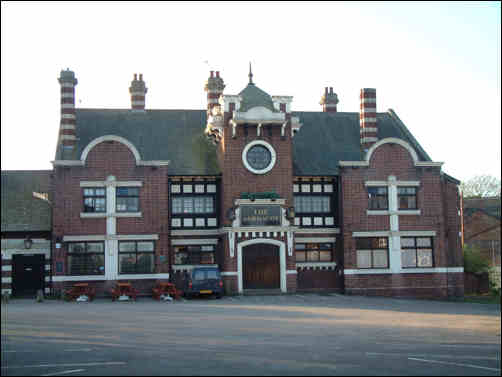There's possible no other
place in Stoke-on-Trent that has been more in the forefront of change
than Normacot. Neolithic remains and Bronze Age pottery said to be the
oldest recovered in North Staffordshire have been found here.
In 1960, a famous hoard of Roman coins was unearthed in a garden at
698 Lightwood Road. Normacot is noted in the Domesday Book. The names of
celebrated families litter its history - Audley, who gave it to the
Hulton monks. John Hunt, of Longton Hall, who developed its iron
industry, handing it on to the Foleys, and the Leverson-Gowers, Dukes of
Sutherland.
There were hundreds of coalmines culminating in the giant Florence
Colliery, named after the Duchess of Sutherland. A principal Roman
route, an important transport road, and now the A50 highway all passed
through it. It was an important centre of the Christian faith; nowadays
it is Longton's centre of Islamic worship. Where do you begin to tell
the story of such a multi-faceted location?
|

The Church of the Holy Evangelists
photo -2006
"I'm told that Normacot grew around the furnace,"
explains parish priest Father Paul Blanch, "Although it is an ancient
part of Stoke-on-Trent, it is surprising that there wasn't a dedicated
church in Normacot until the 2nd Duke of Sutherland commissioned the
distinguished Gilbert Scott to build one in 1847.
"Scott produced a wonderful reflection of an old English church, and
if you look at photographs taken at the turn of the century, you can
see the rural aspects of dusty lanes wandering past to Meir and
Longton along Furnace Lane and Watery Lane. You can't make comparisons
with how it looks now."
The Church of the Holy Evangelists is silent to the outside noise
of Upper Belgrave Road and the persistent comings and goings of
neighbouring Longton Cottage Hospital. But the architecture befits its
time, suspended by circular arched pillars, a wagon-headed roof and
raftered ceiling. There is warmth inside, generated by
locally-quarried sandstone, and newness made by substantial repairs
after the east end was badly damaged by fire 10 years ago.
"Like all Christian churches there have been better days," says
Father Paul. "Our congregation has fallen. And yet funerals are
increasing. I suppose families want to come home to a place they have
affection for. "And surprisingly, baptisms are increasing as well. So
perhaps there are better times ahead." |
Many streets have Scottish names in tribute to the Sutherlands.
And many of these streets have been reoccupied by a buoyant Muslim
community surrounding its place of worship, the Gallani Noor Mosque, in
Chaplin Road. Asian late shops abound.
"My family has owned this shop for 21 years,"
says Mrs Kaur, in Rothsay Road. "We are one of a number of businesses in
the centre of a community which is largely Asian these days. But we all
get along."

The Normacot public house
photo - 2006
Across the road. Kath Jackson has lived in Normacot for 32 years.
"Naturally there have been massive changes
around here," says Kath. "When I first came everyone was British, and
Normacot was known as the posh end of Longton. The mixed community gets
along fine. In fact the biggest division has been caused by the A50
road. "That has completely cut Normacot in two. You just.don't know
what's happening now on the other side around Uttoxeter Road."
You can't help sympathising with Kath's statement. It's not the first
time I hear it while walking around the long terraced rows. The few
lunchtime customers in the Normacot pub still lament the loss of important
community buildings such as the Alhambra Cinema, and indeed the demise of
the public house.
"I don't come out a lot now," says one, supping
a pint while attempting to crack his newspaper crossword. "Banning
smoking has caused untold problems. Well just look around you."
He may be right. The huge room, one of four massive bars in a 1935
ostentatious pile mirrored to match the Kings Arms, at Meir, looks more
inharmonious than the mosque.
Landlords Chris and Laura Probert have been here for 12 months.
"Yes it is a big pub, but we do get a fair
trade at weekends," says Chris. "It has to be admitted that the
community change has had an effect on trade, but the pub still gets used
by the locals who live close by and from farther afield."
Normacot is a place of diverse irony. For instance, Queensbury
Community Centre, the Victorian school which Reginald Mitchell attended,
shares reachable space with the mosque and the incongruous pub.
Gilbert Scott's church is associated with the family of Vera Brittain;
a plaque dedicated by Shirley Williams MP says so. And close by was a
house occupied by Oswald Moseley when his wife Lady Cynthia was once MP
here. In Normacot, history is never far away.